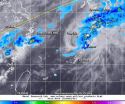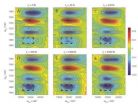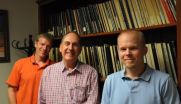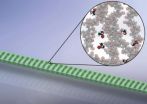(Press-News.org) Tropical Depression Hagibis appeared out for the count when it made landfall along southeastern China on June 16, but moved back into the South China Sea where it regenerated and sped northeast through the East China Sea. The next day, the TRMM satellite noticed power had come back to Hagibis in the form of some moderate rainfall in the depression's northeastern quadrant.
On June 17 at 10:30 UTC (6:30 a.m. EDT) the Tropical Rainfall Measuring Mission or TRMM satellite passed over the regenerated Hagibis and the Precipitation Radar instrument gathered data on the storm's rainfall. The data showed that in the northeastern quadrant of the storm, moderate rainfall was occurring at a rate of 1.4 inches per hour. The TRMM satellite is managed by NASA and the Japanese Aerospace Exploration Agency.
Hagibis was speeding through the Northwestern Pacific Ocean and made it from southeastern China, past Taiwan and Andersen Air Base in one day. On June 17 at 1500 UTC (11 a.m. EDT), Tropical Depression Hagibis' maximum sustained winds had increased up to 30 knots (34.5 mph/55.5 kph) and it was located about 200 nautical miles (230 miles/370 km) northeast of Kadena Air Base, Okinawa, Japan, near 29.6 north latitude and 131.9 east longitude. Hagibis was speeding to the east at 34 knots 39.1 mph/62.9 kph).
The Joint Typhoon Warning Center (JTWC) cited a report that Hagibis passed about 45 nautical miles north of Amami Island, where sustained winds less than 15 knots (17.2 mph/27.8 kph) were reported.
JTWC noted that Hagibis is being battered by vertical wind shear greater than 30 knots, which is elongating the storm. Hagibis has crossed the Kuroshio Current and is now over much cooler sea surface temperatures which will decrease convection (the ability to build the thunderstorms that make up a tropical cyclone).
The Kuroshio Current originates from Taiwan's east coast and flows in a northeasterly direction past Japan, where it joins the easterly movement of the North Pacific Current. The Kuroshio Current has been likened to the movement of the Gulf Stream along the U.S. east coast.
Hagibis is expected to continue on an east-northeasterly track, passing north of Iwo To and staying south of mainland Japan as it heads into the open waters of the Northwestern Pacific Ocean where it will transition into an extra-tropical cyclone in the next day.
INFORMATION:
Text credit: Rob Gutro
NASA's Goddard Space Flight Center
Tropical depression Hagibis gets a second chance
2014-06-17
ELSE PRESS RELEASES FROM THIS DATE:
Sleep education program spurs preschoolers to snooze 30 minutes longer at night
2014-06-17
Ann Arbor, Mich. — Taking part in an educational sleep program resulted in a 30-minute average increase in sleep duration at a one-month follow-up for preschoolers, according to a new study from the University of Michigan.
In the study, published in the journal SLEEP, families in two Head Start programs participated in the Sweet Dreamzzz Early Childhood Sleep Education Program™. The Detroit-area nonprofit organization, Sweet Dreamzzz, Inc. developed the program and offers it for free when funding allows. Head Start programs aim to give preschool opportunities to low-income ...
Dynamic spectroscopy duo
2014-06-17
From allowing our eyes to see, to enabling green plants to harvest energy from the sun, photochemical reactions – reactions triggered by light – are both ubiquitous and critical to nature. Photochemical reactions also play essential roles in high technology, from the creation of new nanomaterials to the development of more efficient solar energy systems. Using photochemical reactions to our best advantage requires a deep understanding of the interplay between the electrons and atomic nuclei within a molecular system after that system has been excited by light.
A major ...
Why species matter
2014-06-17
UC Santa Barbara doctoral candidate Caitlin Fong travels to French Polynesia often but not for vacation. She goes there to study a coral reef ecosystem influenced by human impacts such as overfishing and nutrient pollution.
Her work focuses not only on biological changes but also methods scientists use to determine within-group group responses to ecological processes. The findings are published in ESA Ecology, a journal of the Ecological Society of America.
Fong and Peggy Fong, a professor in UCLA's Department of Ecology and Evolutionary Biology, conducted a study assessing ...
Not so fast -- our fishy friends can also feel pain
2014-06-17
Do you still believe that fish are dumb and cannot feel pain? That we do not have to worry much about how they are cared for or caught? Think again, says Culum Brown of Macquarie University in Australia, in a review article in Springer's journal Animal Cognition. The research notes that fish cognition and their sensory perception are generally on par with that of other animals. Brown therefore argues that more consideration should be given to fish welfare and anti-cruelty issues.
The Australian researcher says that most people rarely think about fish other than as food, ...
$2.4 million NIH center grant to develop a cleaner, healthier environment in Detroit
2014-06-17
DETROIT — With over $2.4 million in new federal funding, Wayne State University researchers, regional collaborators at Henry Ford Health System, the University of Michigan and Michigan State University, and community partners will study how exposures to stressors that are prevalent in the urban industrialized environment — both chemical and non-chemical — impact human health in Detroit and beyond.
The grant, Center for Urban Responses to Environmental Stressors (CURES), is one of approximately 20 select P30 Core Centers funded by the National Institute of Environmental ...
Do 'walkable' neighborhoods reduce obesity, diabetes?
2014-06-17
June 17, 2014 (San Francisco) – People who live in neighborhoods that are conducive to walking experienced a substantially lower rate of obesity, overweight and diabetes than those who lived in more auto-dependent neighborhoods, according to a pair of studies presented at the American Diabetes Association's 74th Scientific Sessions®.
Researchers in Canada compared adults living in the most and least "walkable" metropolitan areas in southern Ontario and found a lower risk of developing diabetes over a 10-year period for those who lived in neighborhoods with less sprawl, ...
Heparin derivative suppresses neuroblastoma tumor growth
2014-06-17
DURHAM, N.C. -- Researchers at Duke Medicine have identified a new strategy for treating neuroblastoma using a modified version of heparin, a century-old injectable drug that thins the blood to prevent clots from forming.
The study, conducted in mice and published June 17, 2014, in the Journal of Clinical Investigation, found that when heparin is altered to remove its blood-thinning properties, it can suppress and shrink neuroblastoma tumors without causing severe bleeding.
"Our research translates mechanistic insights about heparin into a potential new therapy for ...
Urban Water Management Workshop stresses more collaboration and innovation
2014-06-17
RIVERSIDE, Calif. — Where sustainability of water management is concerned, we must pay more attention to long-term solutions. Efficient water management and policy ought to be promoted at the local level. And a "portfolio approach" to water management is encouraged, one that includes information campaigns, different types of pricing, supply and reuse options, and technology-based rebate programs.
These are some of the key messages that emerged from the first Urban Water Management Workshop that took place earlier this month at the University of California, Riverside.
Sponsored ...
Swell new sensors
2014-06-17
WASHINGTON D.C., June 17, 2014 – Using microscopic polymer light resonators that expand in the presence of specific gases, researchers at MIT's Quantum Photonics Laboratory have developed new optical sensors with predicted detection levels in the parts-per-billion range. Optical sensors are ideal for detecting trace gas concentrations due to their high signal-to-noise ratio, compact, lightweight nature, and immunity to electromagnetic interference.
Although other optical gas sensors had been developed before, the MIT team conceived an extremely sensitive, compact way ...
Ultra-thin wires for quantum computing
2014-06-17
WASHINGTON D.C., June 17, 2014 - Take a fine strand of silica fiber, attach it at each end to a slow-turning motor, gently torture it over an unflickering flame until it just about reaches its melting point and then pull it apart. The middle will thin out like a piece of taffy until it is less than half a micron across -- about 200 times thinner than a human hair.
That, according to researchers at the Joint Quantum Institute at the University of Maryland, is how you fabricate ultrahigh transmission optical nanofibers, a potential component for future quantum information ...






